A New Observation in Decoupling and Sequential Rotation Array Configurations Using Loop Radiation Elements
Abstract
1. Introduction
2. Reference Antenna
3. Present Antenna
- Points T and F of the combining lines γm–γm+1 are symmetrical with respect to the center C of the horizontal feedline T–F, and the center is excited with a balanced source (emphasized with + and – in Figure 2);
- Loops #3 and #4 are rotated by 90° around their vertical lines β3–γ3 and β4–γ4, respectively, for the two dual-loop elements to become symmetrical concerning the configuration center C′, at height H, above the horizontal line center C, as shown in Figure 2c. Note that the horizontal feedline has a length of Lf, as shown in Figure 2b.
4. Modified Antenna
- Referring to the loops shown in Figure 3a, we see that loops #2, #1, #3, and #4, are sequentially rotated 90° clockwise around their vertical lines βn–γn. The clockwise rotation makes the phase of partial radiation from each loop progress by 90°, since the antenna radiates a left-hand (EL) CP beam, as shown in Figure 7;
- Referring to a feed network composed of the horizontal feedline F–T of length Lf and combining lines γm–γm+1 of length d, shown in Figure 3b, we recognize that the excitation phases of loops #2, #1, #3, and #4, in turn, are sequentially delayed by 90° (to compensate for a radiation phase progress of 90°), since the line lengths are Lf = d = λ0/2, leading to a sequential increase of λ0/4 in the path length to each loop from the excitation point F.
- (1)
- Which antenna is a proposed one that significantly improves previous research results?
- (2)
- The modified antenna has no improvement in antenna characteristics and provides worse measured results than the simulated ones.
- (3)
- What does the quasi-decoupling mean and in what way can it be quantified?
- (4)
- The decoupling used in the title and the abstract is not obvious.
- (5)
- Dimensions and implementation details are not provided. Therefore, we cannot verify the presented results.
- (6)
- What is the parasitic radiation of relatively long feedlines?
- (7)
- How is the radius of the wire selected to satisfy the impedance matching requirement?
- (1)
- We proposed the modified (sequential rotation) antenna with the widest CP wave bandwidth in previous studies, as shown in Table 1. The present (decoupling) antenna plays a role in finding a new observation in decoupling and sequential rotation array configurations, as in the title. This study claims a new observation as well as a new antenna proposition.
- (2)
- We compare the modified antenna to the reference one since the present antenna has a balanced feed that requires a complicated balun-circuit design for a coaxial-line feed. In addition, the measured results are considered additional data in this study because we verify the MoM results using the FIT ones.
- (3)
- The quasi-decoupling means that it reduces cross-polarized radiation, like authentic decoupling, but without a balanced feed. A reduction in cross-polarized radiation is used to quantify the quasi-decoupling.
- (4)
- The decoupling is used for the following [17]: The cross-polarized radiation is coupled to co-polarized radiation. If the coupling is released (this is called decoupling), the cross-polarized radiation is reduced. The reduction is performed via a cancelation of the cross-polarized, partial radiation from each antenna configuration part, where the antenna comprises two configuration parts symmetrical to the antenna center.
- (5)
- The dimensions and implementation are summarized in Table 2. It is shown that we can design the three antennas by optimizing just two parameters (P, hB). This optimization makes it easy to verify the presented results.
- (6)
- The parasitic radiation from the feedline is smaller than the loop one, since the feedline height above the ground plane needs to be as small as possible, hL = λ0/50, compared to the loop height of H = λ0/4, as shown in Table 2. This smaller parasitic radiation enables us to design the antennas using the loop parameters (P, hB).
- (7)
- For the impedance matching, we do not choose the wire radius ρ but the horizontal feedline height: hL = λ0/50, giving a characteristic impedance of Z0 = 125 Ω. This Z0 matches both the coaxial feed and loop elements.
5. Conclusions
Author Contributions
Funding
Institutional Review Board Statement
Informed Consent Statement
Data Availability Statement
Acknowledgments
Conflicts of Interest
References
- Gao, S.; Luo, Q.; Zhu, F. Circularly Polarized Antennas; John Wiley & Sons, Ltd.: Chichester, UK, 2014. [Google Scholar]
- Ullah, U.; Ain, M.F.; Ahmad, Z.A. A review of wideband circularly polarized dielectric resonator antennas. China Commun. 2017, 14, 65–79. [Google Scholar] [CrossRef]
- Nadeem, I.; Alibakhshikenari, M.; Babaeian, F.; Althuwayb, A.A.; Virdee, B.S.; Azpilicueta, L.; Khan, S.; Huynen, I.; Falcone, F.; Denidni, T.A.; et al. A comprehensive survey on ‘circular polarized antennas’ for existing and emerging wireless communication technologies. J. Phys. D Appl. Phys. 2022, 55, 033002. [Google Scholar] [CrossRef]
- Zeng, W.; Wu, X.; Wu, F.; Zang, Y.; Jiang, Z.; Hong, W.; Luk, K. Broadband dual-CP multi-stage sequential rotation arrays with independent control of polarizations based on dual-CP magnetoelectric dipole elements. IEEE Trans. Antennas Propag. 2024, 4, 3017–3032. [Google Scholar] [CrossRef]
- Hester, D.; Han, S.; Adams, M. Design methodology for single-feed circularly polarized X-band antenna arrays for CubeSats using multilevel sequential rotation. IEEE J. Miniat. Air Space Syst. 2024, 5, 42–50. [Google Scholar] [CrossRef]
- PourMohammadi, P.; Fei, P.; Nasseri, H.; Zheng, Q.; Babarinde, O.; Volski, V.; Vandenbosh, A.; Denidni, T. A single-layer compact wideband circularly polarized patch array for 5G communications. IEEE Antennas Wirel. Propag. Lett. 2023, 22, 754–758. [Google Scholar] [CrossRef]
- Qi, Z.; Zhu, Y.; Li, X. Compact wideband circularly polarized patch antenna array using self-sequential rotation technology. IEEE Antennas Wirel. Propag. Lett. 2022, 21, 700–704. [Google Scholar] [CrossRef]
- Santosa, C.E.; Sumantyo, J.; Gao, S.; Ito, K. Broadband circularly polarized microstrip array antenna with curved-truncation and circle-slotted parasitic. IEEE Trans. Antennas Propag. 2021, 69, 5524–5533. [Google Scholar] [CrossRef]
- Sun, M.; Liu, N.; Zhu, L.; Fu, G. Wideband circularly polarized sequentially rotated microstrip antenna array with sequential-phase feeding network. J. Commun. Inf. Netw. 2020, 5, 350–357. [Google Scholar] [CrossRef]
- Zhang, Y.; Zhu, L. Printed dual spiral-loop wire antenna for broadband circular polarization. IEEE Trans. Antennas Propag. 2006, 54, 284–288. [Google Scholar] [CrossRef]
- Li, R.; DeJean, G.; Laskar, J.; Tenzeris, M.M. Investigation of circularly polarized loop antennas with a parasitic element for bandwidth enhancement. IEEE Trans. Antennas Propag. 2005, 53, 3930–3939. [Google Scholar]
- Sumi, M.; Hirasawa, K.; Shi, S. Two rectangular loops fed in series for broadband circular polarization and impedance matching. IEEE Trans. Antennas Propag. 2004, 52, 551–554. [Google Scholar] [CrossRef]
- Hirose, K.; Kikkawa, Y.; Nakano, H. Decoupling and sequential array antennas—Effects of coplanar feedline on radiation characteristics. IEEE Antennas Wirel. Propag. Lett. 2020, 19, 423–427. [Google Scholar] [CrossRef]
- Hirose, K.; Nishino, K.; Nakano, H. Dual-loop antennas with an expanded axial ratio bandwidth. Electron. Lett. 2023, 59, e12784. [Google Scholar] [CrossRef]
- Hirose, K.; Nakatsu, M.; Nakano, H. Dual-curl antennas for broadband circular polarisation. Electron. Lett. 2021, 57, 542–544. [Google Scholar] [CrossRef]
- Harrington, R.F. Fields Computation by Moment Methods; Macmillan: New York, NY, USA, 1968. [Google Scholar]
- Shelley, M.W.; Brain, D.J.; Roederer, A.; Markus, K. A novel high efficiency, dual polarised, flat plate array. In Proceedings of the Eighth International Conference on Antennas and Propagation, Edinburgh, UK, 30 March–2 April 1993. [Google Scholar]
- Nakano, H.; Matsumoto, S.; Ochiai, N. Improvement of the axial ratio for circularly polarized multi-arm antenna. In Proceedings of the Combined Conference of Four Institutions Related to Electrical Engineering, Japan, October 1975. [Google Scholar]
- CST Studio Suite. Available online: https://www.cst.com/applications/mwandrf (accessed on 25 December 2024).



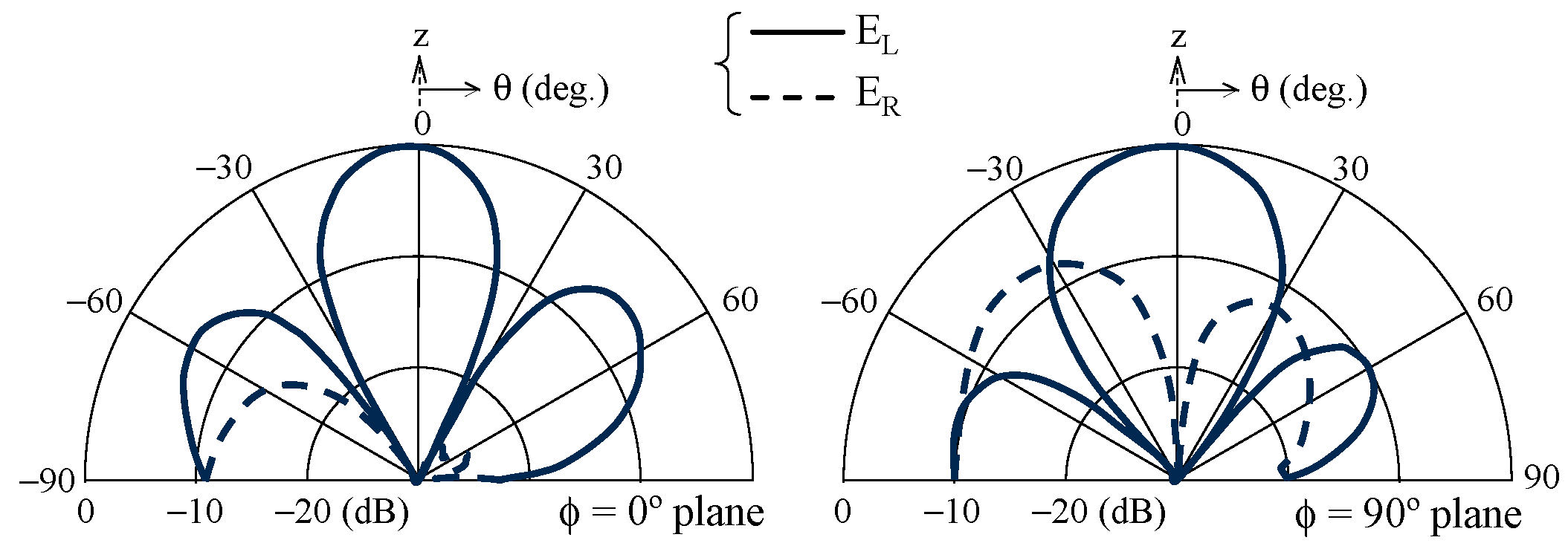
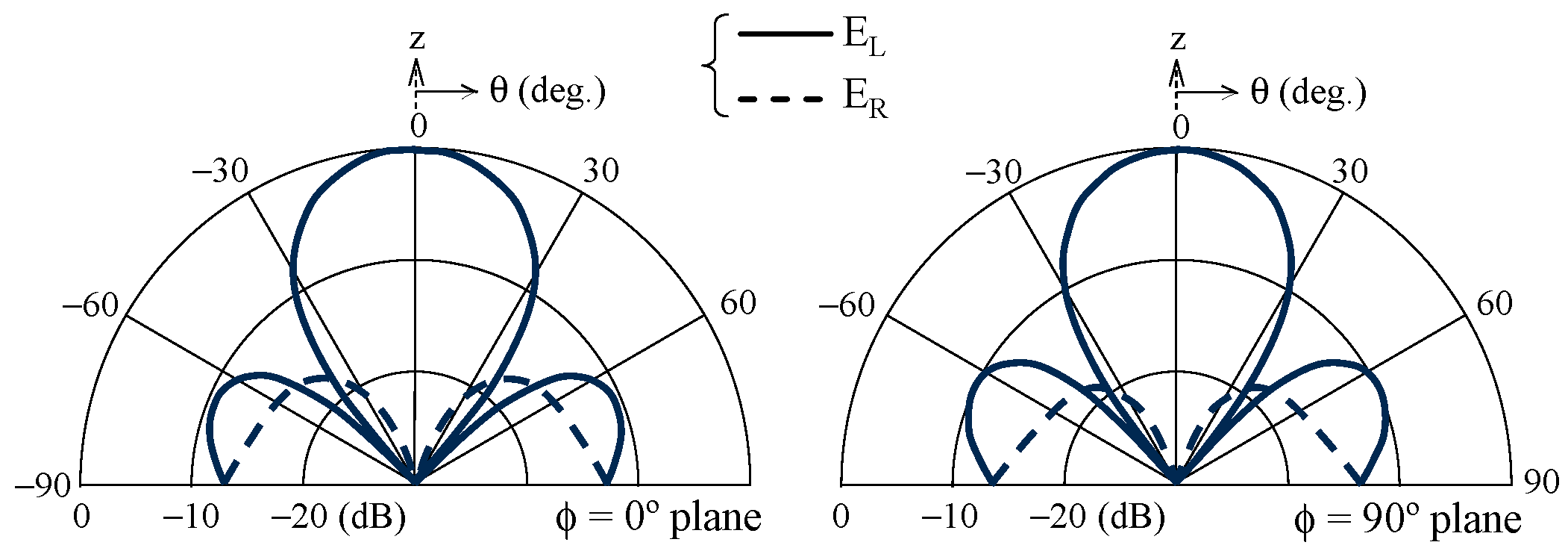
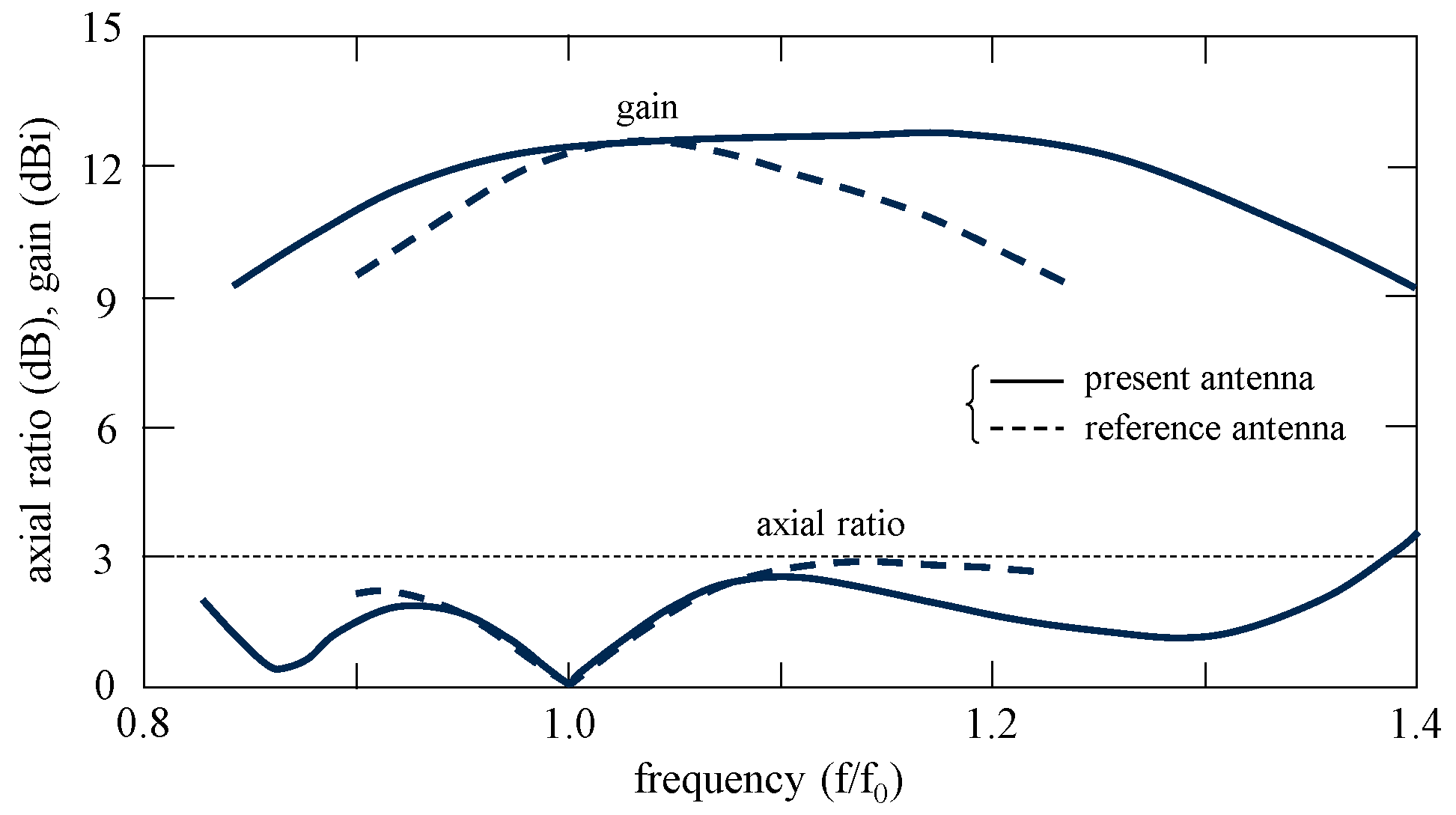
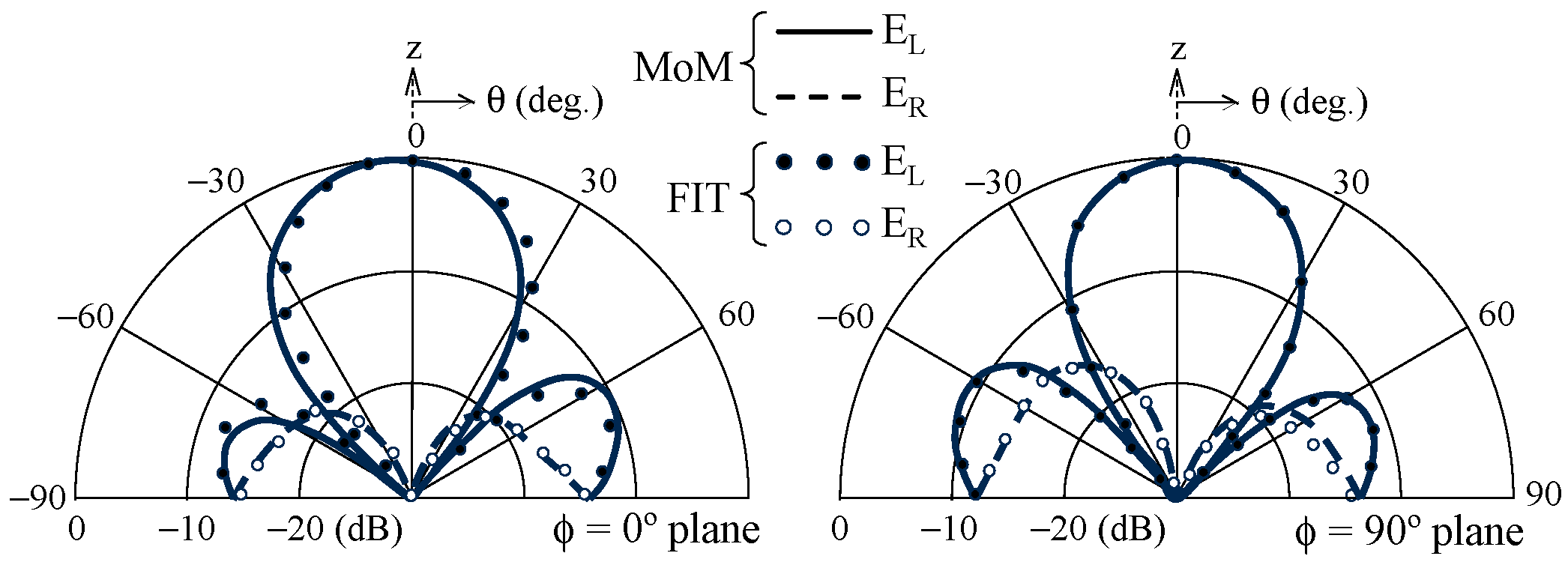

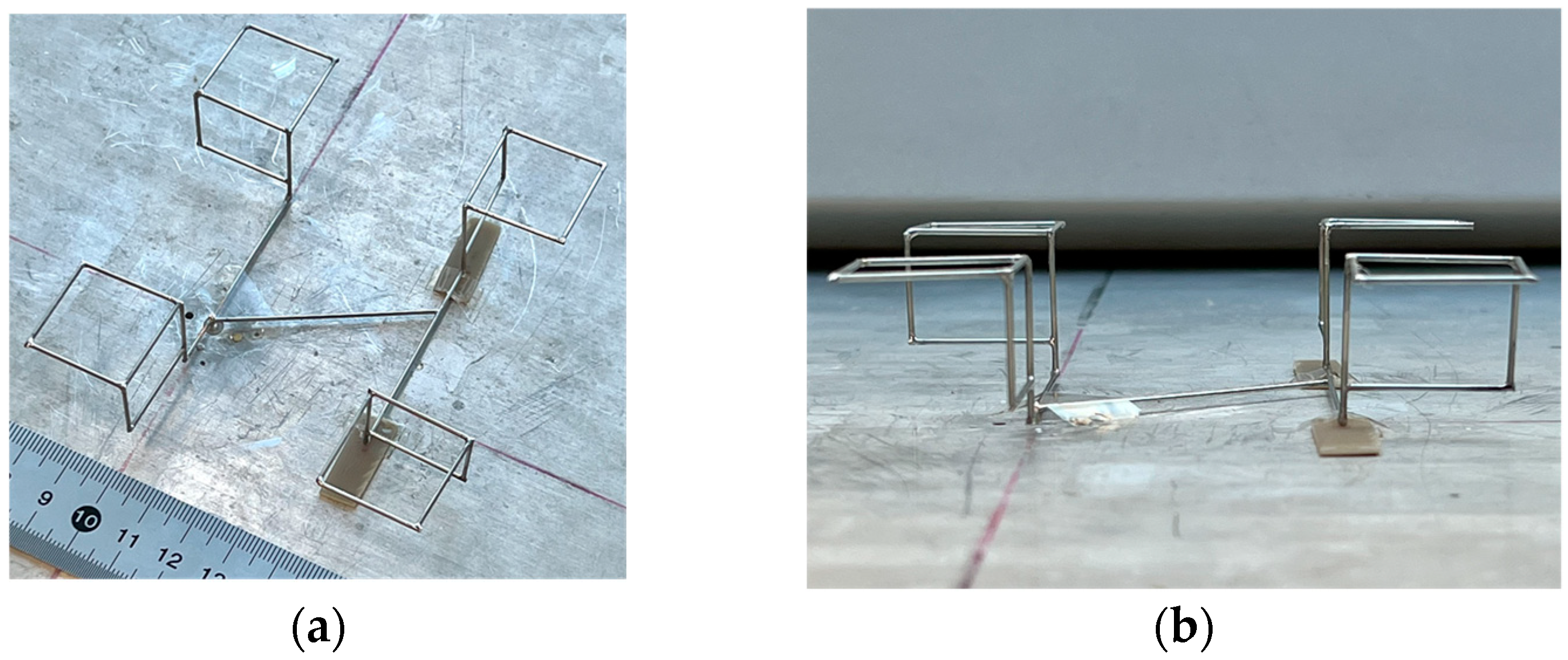
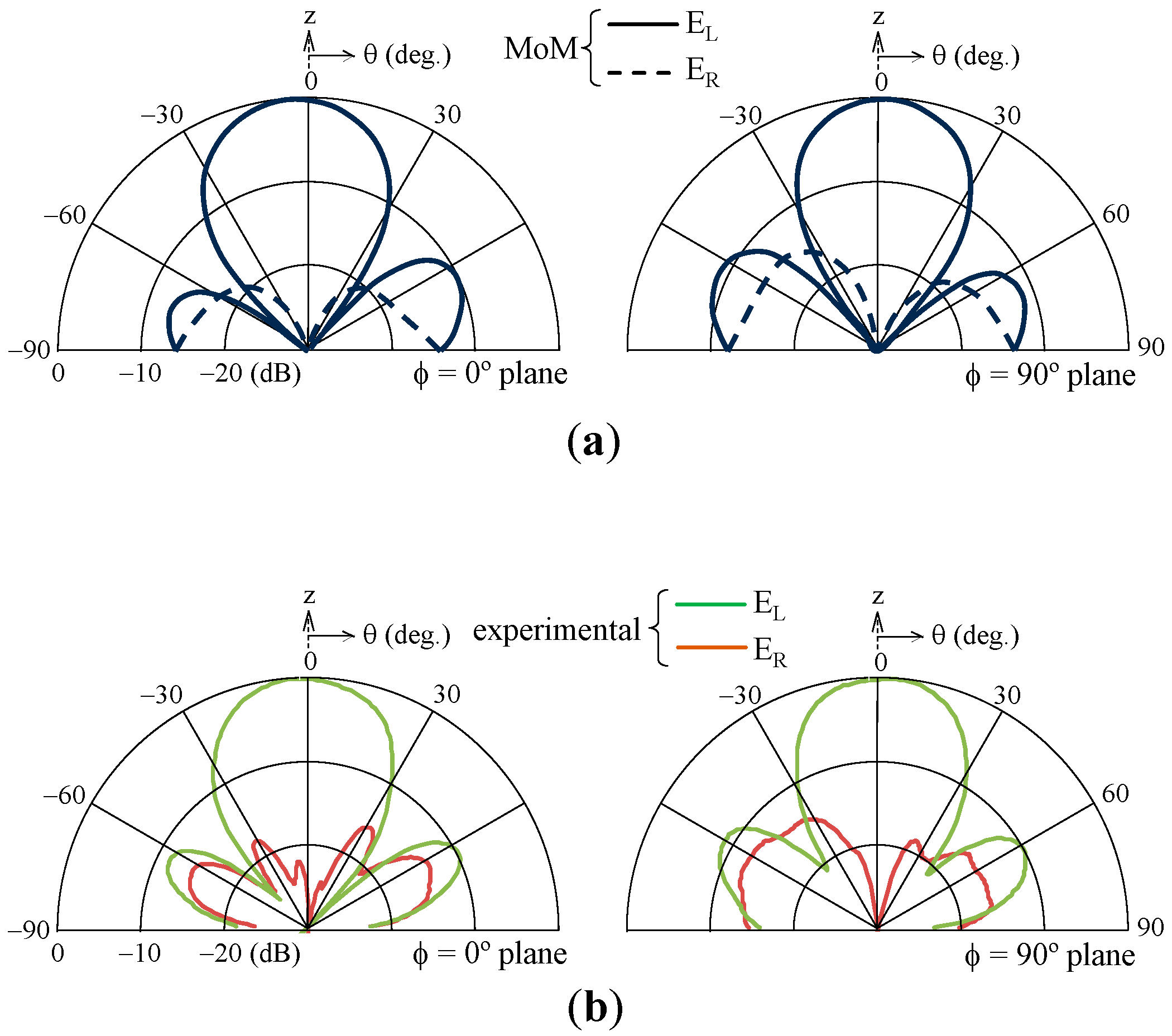
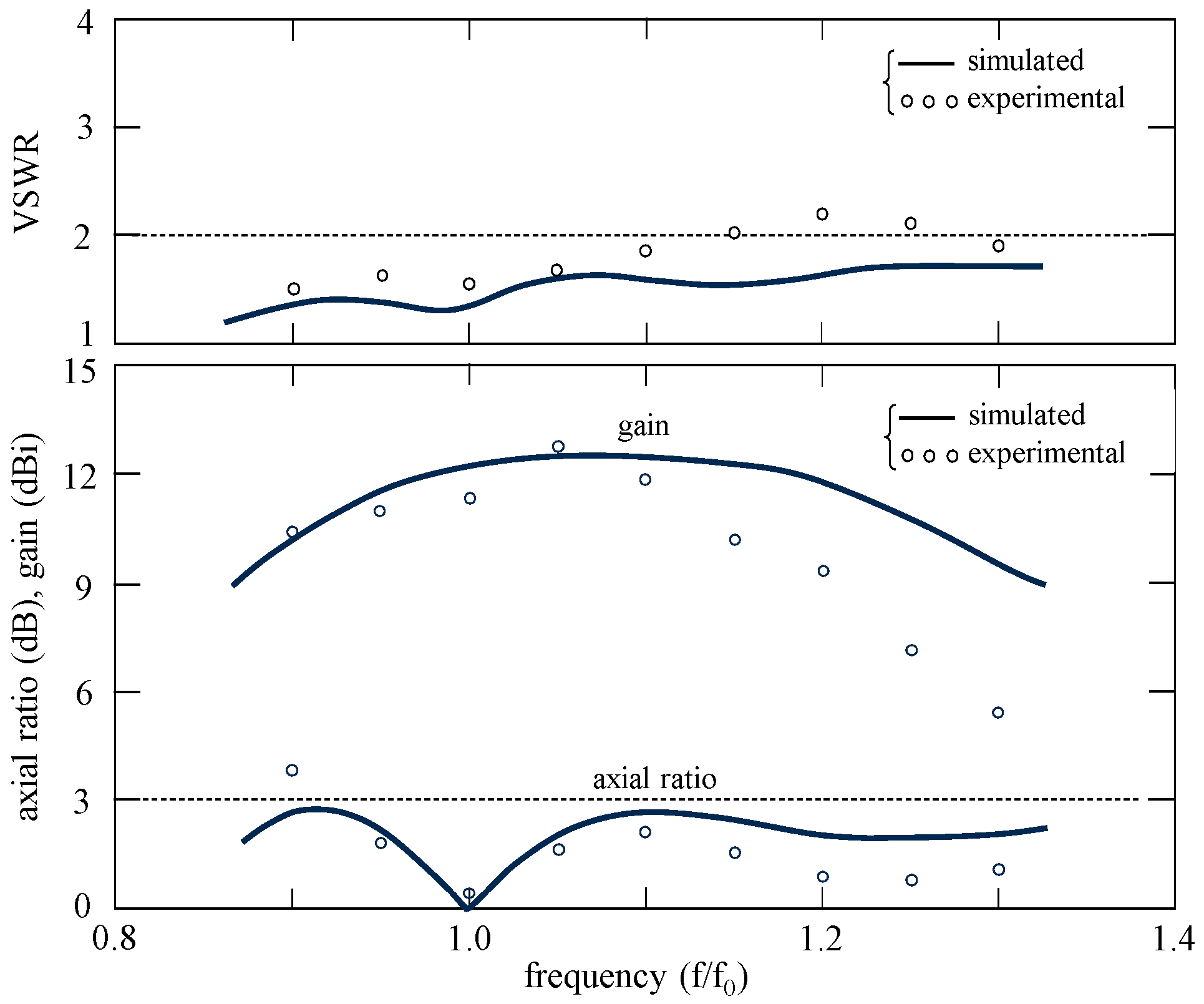
| Study | Array Type | Array Feed | Radiation Element | 3 dB Axial Ratio Bandwidth (%) | Gain (dBi) | Operating Frequency (GHz) |
|---|---|---|---|---|---|---|
| [4] | 2 × 2 | multi-layer H-figured FL 1 | magnetoelectric dipole | 21.9 | 12.4 | 21 |
| [5] | 2 × 2 | coplanar C-figured FL 1 | patch | 8.3 | 10.8 | 8.25 |
| [6] | 2 × 2 | coplanar O-figured FL 1 | patch | 20.2 | 13.8 | 28 |
| [7] | 2 × 2 | back cavities | patch | 23.9 | 14.6 | 64 |
| [8] | 2 × 2 | coplanar C-figured FL 1 | patch | 15 | - 2 | 5.3 |
| [9] | 2 × 2 | coplanar C-figured FL 1 | patch | 20.4 | 11.1 | 27 |
| present | 2 × 2 | multi-layer H-figured FL 1 | loop | 39 | 12.5 | 3 |
| Implementation | Parameters | Antennas | |||
|---|---|---|---|---|---|
| Antenna Part | Notation | Reference (λ0) | Present (λ0) | Modified (λ0) | |
| optimization | loop perimeter | P | 0.88 | 0.92 | 0.91 |
| branch height of vertical feedline αn/βn–Bn–γn | hB | 0.08 | 0.09 | 0.08 | |
| precedent | length of horizontal feedline F–T | Lf | 1 | 1/2 | |
| loop distance in dual element | d | 1/2 | |||
| loop height | H | 1/4 | |||
| height of horizontal feedline F–T | hL | 1/50 | |||
| wire radius | ρ | 1/200 | |||
Disclaimer/Publisher’s Note: The statements, opinions and data contained in all publications are solely those of the individual author(s) and contributor(s) and not of MDPI and/or the editor(s). MDPI and/or the editor(s) disclaim responsibility for any injury to people or property resulting from any ideas, methods, instructions or products referred to in the content. |
© 2025 by the authors. Licensee MDPI, Basel, Switzerland. This article is an open access article distributed under the terms and conditions of the Creative Commons Attribution (CC BY) license (https://creativecommons.org/licenses/by/4.0/).
Share and Cite
Hirose, K.; Nishino, K.; Nakano, H. A New Observation in Decoupling and Sequential Rotation Array Configurations Using Loop Radiation Elements. J 2025, 8, 9. https://doi.org/10.3390/j8010009
Hirose K, Nishino K, Nakano H. A New Observation in Decoupling and Sequential Rotation Array Configurations Using Loop Radiation Elements. J. 2025; 8(1):9. https://doi.org/10.3390/j8010009
Chicago/Turabian StyleHirose, Kazuhide, Koki Nishino, and Hisamatsu Nakano. 2025. "A New Observation in Decoupling and Sequential Rotation Array Configurations Using Loop Radiation Elements" J 8, no. 1: 9. https://doi.org/10.3390/j8010009
APA StyleHirose, K., Nishino, K., & Nakano, H. (2025). A New Observation in Decoupling and Sequential Rotation Array Configurations Using Loop Radiation Elements. J, 8(1), 9. https://doi.org/10.3390/j8010009






